A closer look at South Carolina’s principal advocate for natural resources
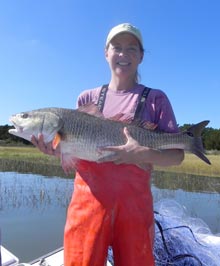 In a previous career, I was the Naturalist at Hunting Island
In a previous career, I was the Naturalist at Hunting Island State Park, one of 47 State parks in SC. I was awed daily with the environment of the ever-changing barrier island and the many species that called it home. I became intrigued with the dynamics of the salt marsh, the varying habitats of the maritime forest, the fragility of the sand dunes, and the impact of the human element that influenced the island’s ecology on a daily basis. It was truly amazing to understand how everything was interconnected, how the different ecosystems affected each other, how the life cycle of plants and animals continue to evolve and how we, as a species, help and hinder nature’s progress.
State Park, one of 47 State parks in SC. I was awed daily with the environment of the ever-changing barrier island and the many species that called it home. I became intrigued with the dynamics of the salt marsh, the varying habitats of the maritime forest, the fragility of the sand dunes, and the impact of the human element that influenced the island’s ecology on a daily basis. It was truly amazing to understand how everything was interconnected, how the different ecosystems affected each other, how the life cycle of plants and animals continue to evolve and how we, as a species, help and hinder nature’s progress.
I worked with the South Carolina Department of Natural Resources (SCDNR or DNR) on a weekly basis, assisting with resource management, delivering educational programs to students and visitors and keeping proper records for various research projects. DNR’s mission is to serve as the principal advocate for and steward of South Carolina’s natural resources. South Carolina Parks, Recreation and Tourism’s (SCPRT or PRT) mission is to Grow South Carolina’s economy by fostering sustainable tourism economic development and effectively market our state to increase visitation and improve the quality of life for all South Carolinians. So, the purpose of each department differs; yet the vision of both equally promotes quality of life in South Carolina for present and future generations.
So it was important that both agencies work together to improve understanding of the wise use and safe enjoyment of healthy, diverse, sustainable and accessible natural resources.
Recently, Dr. Al Segars, DNR’s steward of the ACE Basin, invited me to participate in a few research projects currently underway in coastal SC. Of course, I obliged, eager to get my hands dirty and reminisce with my previous career.
The three projects I’ll discuss in this article are just a few of the many, many tasks assigned to a multitude of departments within SCDNR. To understand the full magnitude of DNR’s responsibilities, just visit their website, www.dnr.sc.gov. It’s not just a group giving marine tickets for unsafe boating practices. Oh no… South Carolina’s premier agency for protecting our coastal, midland and mountain regions diligently operates a variety of conservation initiatives. Their commitment to land, water and wildlife in South Carolina is admirable and worth your attention.
Part I: A Fish Tale
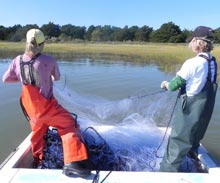 A couple of weeks ago, I had the privilege of participating in a DNR research project in the ACE Basin with Bill Roumillat, a biologist with the Inshore Fisheries Research Section of the Marine Resources Research Institute. Roumillat’s research emphasis includes biology of fishes, histologically verified fish reproductive ecology and fish behavioral ecology. His current research projects include life history investigations of estuarine fishes, red drum fisheries dynamics and autochthonous fish sounds as related to fishery dynamics.
A couple of weeks ago, I had the privilege of participating in a DNR research project in the ACE Basin with Bill Roumillat, a biologist with the Inshore Fisheries Research Section of the Marine Resources Research Institute. Roumillat’s research emphasis includes biology of fishes, histologically verified fish reproductive ecology and fish behavioral ecology. His current research projects include life history investigations of estuarine fishes, red drum fisheries dynamics and autochthonous fish sounds as related to fishery dynamics.
It was a picture perfect November day in the ACE Basin. ACE is an acronym for the Ashepoo, Combahee and South Edisto rivers that make up one of the largest undeveloped estuaries on the east coast of the United States. Roumillat, myself, Weatherly Meadors, a graduate student in Marine Biology at the College of Charleston and Mitch Helms, Interpretive Program Manager at Hunting Island State Park left the research facility at Bennett’s Point early to begin sampling at the start of the ebbing tide. We cruised out in a “Florida mullet boat” and approached the first station while Roumillat and Meadors gave instructions on how to operate the trammel net.
Helms and Meadors set the 200 yard long, 8 foot deep net in an arc against the marsh to seal off the area. They artificially disturbed the water with large poles to imitate predatory activity and then hauled the net to retrieve the sample. The first set was typical: spots, flounder, spotted trout, black drum and even a blue crab. We counted and identified the species and measured fork and total lengths, then released them back in the water.
The second set was the money hole. Any fisherman would have loved to be casting the rod in this spot. In addition to the species mentioned above, we netted seven red drum, each measuring 40 inches and above. We measured and tagged them and also took a couple scales from the pectoral fins to determine age and released them back into the water.
We sampled a total of nine stations that day. The process became laborious, and I figured out quickly how Roumillat stayed in shape. He’s been sampling estuaries along the coast from the ACE Basin to Winyah Bay since 1991. His research helps other biologists at the lab conduct studies on various species with relationship to abundance, reproduction and eating habits and migra tory patterns, among other interests.
tory patterns, among other interests.
The Red Drum or Spottail Bass, the most highly prized inshore gamefish in the state, is strictly regulated. Since designation as a gamefish in 1985, the regulations applied to the harvest of this species have been altered eight times by the legislature. Depending on research findings, some years show major decline in juvenile and/or adult fish. With the advent of bag (creel) and size limits, there has been a gradual increase in the estimated number of red drum caught and released alive in the fishery.
And, with the help of cooperating anglers, close to 45,000 red drum have been tagged since 1989. Approximately 7,000 of these fish have been recaptured. The angling public has provided biologists with valuable information on movement, seasonality trends, growth rates and general population dynamics of this highly sought after gamefish.
Redfish Tips: Captain Dan Utley reports the incoming tide is best to fish since the water has started to cool. Also, the winds have calmed a bit making the water start to clear; so artificial baits like Gulp Shrimp in the New Penny color are working great. Fish the grass edges on the rising water and also back in the grass as the water gets higher. On low tide, Redfish are also starting their schooling pattern and can be caught with 1/4 ounce jigs and a Gulp Shrimp or Gold Spoons. The best time of the year for sight fishing Redfish is right around the corner.
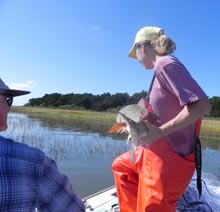
Red Drum (Sciaenops ocellatus)
General Description – Iridescent silver-gray with a copper cast, darker above; one or more oscillated spots on upper sides from below soft portion of dorsal fin to base of caudal fin. Mouth inferior and horizontal, teeth set in bands on both jaws. Chin without barbels, smooth pre-opercular margin.
Average Size – 18 inches, 2.6 pounds; South Carolina State Record: 75 pounds (1965); maximum age: approx. 38 years (a few individuals as old as 60 have been reported in other states).
Habitat
Adults: Utilize nearshore and inshore bottom habitats, such as tidal creeks, oyster reefs, and beaches, typically over sandy or sandy-mud bottoms; may also congregate in nearshore groups.
Juveniles: Inhabit estuaries near shallow tidal creeks and salt marshes, commonly at marsh grass edges or in the vicinity of oyster reefs; reside in deeper river channels during winter. Subadults inhabit larger tidal creeks, rivers, and the front beaches of barrier islands.
Reproductive Cycle
• Adults mature by 3 – 5 years of age; approximate length at maturity: males – 28 inches, females – 33 inches.
• Spawn during late summer and fall. Spawning aggregations occur near estuary inlets and passes along barrier island beaches. Males produce drumming sounds using muscular contractions to vibrate the swimbladder, to attract females.
• Larval red drum use vertical migrations to ride high salinity tidal currents into tidal creeks and shallow salt marsh nursery habitats.
Foraging Habits
• All sizes of red drum are predatory foragers on or near the bottom; inshore foraging (juveniles) typically occurs at marsh grass edges.
• Adults: Feed primarily on menhaden, spot, anchovies, blue crab, and speckled crab.
• Juveniles: Feed on opossum shrimp, grass shrimp, juvenile spot, and mud minnows, mud crabs, and fiddler crabs. Subadult diet is similar to adult fish. Larvae feed primarily on zooplankton and small invertebrates.
Availability/Vulnerability to Harvest
• Present in South Carolina waters year-round. Distribution is predominantly temperature dependent: juvenile fish progress from marshes and tidal creeks to overwinter in deeper inshore waters; larger adults overwinter offshore and return to nearshore waters during spring.
• No commercial red drum fishery currently exists in South Carolina; potential for recreational harvest is significant since legal size fish inhabit inshore and nearshore waters during a large portion of the year.
• Conservation concerns: degradation and loss of estuarine habitats; lack of information on South Carolina spawning locations; maintenance of optimal numbers of subadult and spawning size fish.
Abundance of Species
Most red drum caught in the SCDNR trammel net survey are between 9 and 30 inches (the current slot is 15-23 inches) and are younger than 4 years old. Therefore, abundance presented here is heavily influenced by successful recruitment. Bigger fish become mature and move into deeper waters, where they might live for 20 or 30 years. A separate long-line survey is used to study these older fish.
Fishery Status
Red drum is a highly prized recreational species. It acquired game fish status in 1987, making it illegal to harvest commercially. Over the years, changes in regulations and conservation ethic have led to a fishery in which the majority of fish are released alive.
The recreational catch data is provided by the National Marine Fisheries Service (NMFS), which conducts phone and angler-intercept surveys to monitor angler activities and catches. For more information, see www.st.nmfs.noaa.gov/st1/recreational.
Part II: The Migration of the Red Knot
Soon after being hired as the Naturalist at Hunting Island, I became a birder. Not knowing anything about birds before my career, it wasn’t long before I understood the fascination. The misconception about “birders” is that they immediately know a species upon sight or sound. Well, the professional birders may; but most people who enjoy the hobby simply sight birds through binoculars and identify unfamiliar varieties with a bird book. I do it all the time with my Sibley’s, the bible of bird identification!
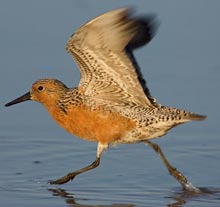 So I was especially grateful when Dr. Segars invited me to Harbor Island, along with Felicia Sanders and Janet Thibault of the US Fish and Wildlife Service, Debrah Cramer, author of Smithsonian Ocean: Our Water, Our Ocean and Great Waters: An Atlantic Passage and John and Diane Fisk, Harbor Island residents and Lowcountry Master Naturalists. It was the Fisks that alerted state and federal officials of the Red Knot sightings on Harbor Island in late October.
So I was especially grateful when Dr. Segars invited me to Harbor Island, along with Felicia Sanders and Janet Thibault of the US Fish and Wildlife Service, Debrah Cramer, author of Smithsonian Ocean: Our Water, Our Ocean and Great Waters: An Atlantic Passage and John and Diane Fisk, Harbor Island residents and Lowcountry Master Naturalists. It was the Fisks that alerted state and federal officials of the Red Knot sightings on Harbor Island in late October.
The Red Knot is the largest of the “peeps” in North America, and one of the most colorful. It makes one of the longest yearly migrations of any bird, traveling 15,000 km (9,300 mi) from its Arctic breeding grounds to Tierra del Fuego in southern South America. And more Red Knots, preferring sandy beaches and mud flats, are wintering on Harbor Island every year.
We spotted about 400-500 Red Knots, feeding and roosting among sanderlings, terns, skimmers and plovers. Sanders and Thibault took note of the coveted species. They, along with biologists from other agencies, are studying the Red Knots, which have recently experienced a steep population decline.
This decline is due in large part to the overharvesting of Horseshoe Crabs in the New Jersey and Delaware areas. Red Knots depend on the nesting congregations of Horseshoe crabs to provide a feast of crab eggs during a critical part of the Red Knots’ migration. The birds arrive from South America with low fat reserves and without the bounty of crab eggs in spring, the birds are much less able to arrive on the breeding grounds in good health.
Research indicates that a small portion of the Red Knot population is wintering along the South 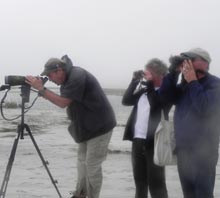 Carolina coast, rather than traveling all the way to South America or joining a few thousand other east coast migrants at their winter destination in west Florida. It is not completely known whether the Knots’ wintering in SC is a recent development or whether a portion of the population has always done this.
Carolina coast, rather than traveling all the way to South America or joining a few thousand other east coast migrants at their winter destination in west Florida. It is not completely known whether the Knots’ wintering in SC is a recent development or whether a portion of the population has always done this.
In order to better understand the migrating and wintering patterns of Red Knots, biologists like Sanders and Thibault have captured small numbers of Red Knots and fastened numbered tags to their legs. These birds have been captured at sites along the east coast of North America, as well as at South American Sites. Researchers are desperately seeking information and photographic evidence regarding the resightings of these ‘marked’ shorebirds.
Volunteers, such as the Fisks, are key to finding and documenting marked Red Knots and other shorebirds and reporting sightings to authorities.
Cramer, a celebrated environmental author, is currently writing a book about the Red Knot and is accompanying biologists around the globe studying the species. She was especially excited to see so many Red Knots on the southernmost tip of the island, which has been accreting at a rapid rate in recent years.
About the Red Knot:
Red knots raise only one brood per year. Nests are constructed near water on shallow depressions lined with leaves and lichens. Both adults incubate 3-4 olive-buff eggs for about 3 weeks. Young red knots fledge 18-20 days after hatching. This species feeds on mollusks, marine worms, and horseshoe crab eggs. During migration, knots gather in huge flocks, stopping along coastal areas to recharge their energy reserves for their flight to wintering grounds in Central and South America. Near Delaware Bay, their migration stopover coincides with the horseshoe crab’s annual spawning. The abundance of horseshoe crab eggs provides ample protein for the migrating knots. In recent times, however, habitat alteration and human activities have threatened populations of horseshoe crabs thus indirectly putting migrating birds such as the red knot, at risk.
Part III: The S.C.O.R.E. Project
 Another important task assigned to SCDNR is managing our oyster population. The S.C.O.R.E Project, which stands for South Carolina Oyster Restoration and Enhancement, is a community-based habitat restoration project. Oysters play a significant ecologic and economic role in South Carolina; however, oyster populations are declining.
Another important task assigned to SCDNR is managing our oyster population. The S.C.O.R.E Project, which stands for South Carolina Oyster Restoration and Enhancement, is a community-based habitat restoration project. Oysters play a significant ecologic and economic role in South Carolina; however, oyster populations are declining.
Volunteers, area restaurants and SCDNR officials work together every season in an effort to plant recycled oyster shells in the intertidal environment to form new, self-sustaining oyster reefs. Thousands of bushels of oysters are shucked every year, and it takes a coordinated effort to get those shells back in the water, where they belong. You see, new oysters grow from existing shells. The more shells, the larger the beds, which improve water quality, control erosion and provide habitat for other commercially-important shellfish and fish species. Not to mention, they are simply delicious and South Carolina’s favorite salty treat!
There are four locations in Beaufort County to recycle your shells: the Beaufort Bin on Shanklin Road, the Port Royal Bin at The Sands, the Hunting Island Bin at Russ Point Boat Landing and the Bluffton Bin at Trask Boat Landing. When the season is over, volunteers bag those shells and arduously take them to the water along the marsh to make new oyster beds.
After the reefs are constructed, volunteers are trained to monitor water quality, reef development, and reef/shoreline interactions. The overall goal of the S.C.O.R.E. program is to protect this natural resource by increasing citizen awareness of the ecological importance of oyster habitats and the potential negative effects of human activities on these fragile systems.
Since S.C.O.R.E.’s inception, 188 oyster reefs have been constructed at 35 sites spanning 200 miles of coastline from Murrell’s Inlet to Hilton Head.
Why Do Oyster Habitats Need to Be Restored?
Human activities, in concert with natural phenomena, have greatly affected the distribution and 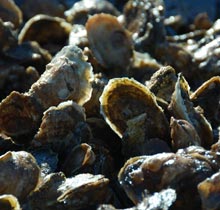 abundance of oysters in the United States. In many areas, oyster habitats have declined precipitously in recent years due to many causes, including overharvesting, destruction of habitat, water pollution, and other effects related to coastal development. The loss may be most severe in the Chesapeake Bay, where only 1 percent of the historical oyster resources still remain.
abundance of oysters in the United States. In many areas, oyster habitats have declined precipitously in recent years due to many causes, including overharvesting, destruction of habitat, water pollution, and other effects related to coastal development. The loss may be most severe in the Chesapeake Bay, where only 1 percent of the historical oyster resources still remain.
While the intertidal oysters of South Carolina may still appear to be abundant there is increasing evidence of negative effects from anthropogenic (man-made) stressors such as nonpoint source runoff and wakes from increasing recreational boat traffic. In fact, in many of the more heavily utilized creek systems, essentially no oysters remain.
South Carolina oyster resources also suffer from a lack of husbandry (conservation), particularly in the common property grounds managed by the state. Appropriate husbandry includes replanting of oyster shell to provide substrate for subsequent generations. If removal of oysters by harvesting is not offset by replanting, the resource declines due to reduced sufficient substrate.
How Can We Restore Oyster Habitat?
Oysters will readily recruit to planted shell substrate in areas that otherwise have little or no recruitment due to lack of suitable attachment sites. In South Carolina there are adequate breeding populations (adult stocks) but recruitment is limited by substrate. Although a fully functional reef requires 3 to 5 years to develop, an impressive suite of invertebrates (over 85 species) quickly colonizes the oyster reefs, providing food sources for larger invertebrates and finfish and beginning the natural process of stabilizing the reef.
Planting of bare shell can also help to trap sediments and absorb wave energy, reducing erosion of adjacent salt marshes. With careful site selection, replanting of shell can restore oyster habitat by providing substrate for juvenile oysters, which grow to form a self-sustaining reef.
Recycling Do’s and Don’ts
• DO separate shell from trash. Shell mixed with trash is not suitable for recycling. Provide separate containers for shell and trash.
• DO dump shells from bags or containers and leave only shells in the bins.
• DO bring your shell to the nearest shell recycling center. Maps are provided below. If a center is not shown near you, please call 843-953-9397.
• DON’T put live oysters in South Carolina waters. If the oysters you purchased were harvested outside South Carolina, it is illegal to place them in SC waters. Placing imported oysters in our waters can create environmental problems and may harm local oysters or other animals.
• DON’T put freshly shucked oysters shell in SC waters. To avoid contamination, shell should be recycled to DNR and properly quarantined for 6 months.
Your license recycles!
Many SCDNR projects are funded by the revenue generated by Saltwater Recreational Fishing License sales. You can buy them online at http://www.dnr.sc.gov/purchase.html or call 1-866-714-3611. An annual South Carolina resident license is $10.








